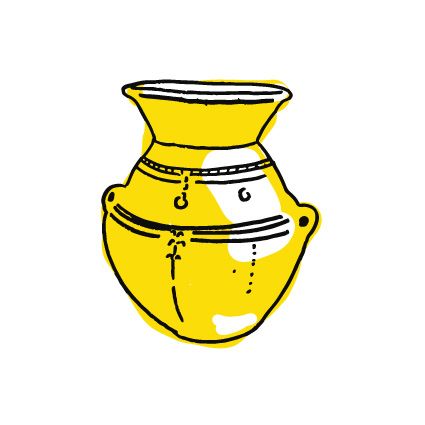
Ovális testű, kerek talpon álló, 6,5 cm magas agyagpohár, alakja a tojástartókra hajaz. Peremén rovátkolás, oldalán vékonyan bekarcolt vonalas és pontkörös díszítés látható. Tetejének egy része hiányzott, ez a restaurálás során ki lett egészítve. Előkerülési helye Veszprémben a Nagytó és Roboz utcák kereszteződése, ahol 1942-ben 4 hamvasztásos sírt találtak. Az edények mellett egy nyakperec, karspirális és átfúrt fejű tű is volt helyezve a hamvak mellé. A sírok leletanyaga a bronzkorra keltezhető.
Hasonló miniatűr edények gyakran szerepeltek sírokban normális méretű társaik mellett. Nem használati tárgyak voltak, inkább csak szimbolikus jelentőségük lehetett. Méretük okán könnyen kézbe vehetőek, tenyérbe simulnak, így közelebbről lehet megcsodálni a korszakra jellemző egyedi díszítésmódot, a bekarcolt vonaldíszítést ugyanis eredetileg fehér anyaggal töltötték ki. A minta elnevezése mészbetétes, de ma már ismert, hogy mész helyett hamvakat használtak a kitöltőanyag elkészítéséhez.
Őskoros régészként engem tanulmányaim kezdetétől fogva vonzott a bronzkor, mely sokszínűségével a Kárpát-medencei őskor leggazdagabb időszakának mondható. Hallgatóként a Laczkó Dezső Múzeumnál töltöttem múzeumi gyakorlatomat, mely során a raktári revízióban vettem részt. Itt volt szerencsém először kézbe venni azokat a tárgyakat, melyekkel azelőtt csak képen találkoztam, ez az élmény azóta is visszaköszön, valahányszor elém kerül a történelem egy-egy kis darabja.
Sebestyén Noémi
régész
Erre haladjon tovább:
A U alakú fal bal oldalán egy római pohárról olvashatunk.
Clay cup, with a height of 6.5 centimeters, standing on a circular base, with an oval body, its overall shape resembles an egg holder. There is notching on its rim, and an engraved linear and dotted circle decoration visible on its side. A missing fragment at the top was remade during the restoration process. It was found at the intersection of the Nagytó and Roboz streets, where four cremation burials were found. In addition to the vessels, a torc, a spiral bracelet and a pin with a perforated head were put next to the ashen remains. The grave finds can be dated to the bronze age.
Similar miniature vessels are commonly found in graves, next to their regular sized counterparts. They most likely served a symbolic purpose and were not used in everyday life. Due to their small size, they can be easily held as they can fit in the palm of our hands. Because of this, the intricacies of the period's characteristic decoration methods can be observed up close, since the linear engravings were originally filled with a white substance. This decorative form was named lime-inlaid, but it is well known today that instead of lime, they used ashes for the making of this filling material.
As an archeologist specializing in prehistory, I have had a particular interest in the Bronze Age since the beginning of my studies, which period can be called the richest period of the Carpathian-basin. As a university student I spent my apprenticeship at the Lackzó Dezső Museum, where I took part in the inventory audit. This was my first opportunity to actually hold the items that I only saw on pictures before, this experience stayed with me since then. Whenever a small piece of history comes before me, I remember that first experience.
Noémi Sebestyén
archeologist
Proceed to this:
On the left side of the ‘U’ shaped wall, you can learn about a Roman drinking glass.